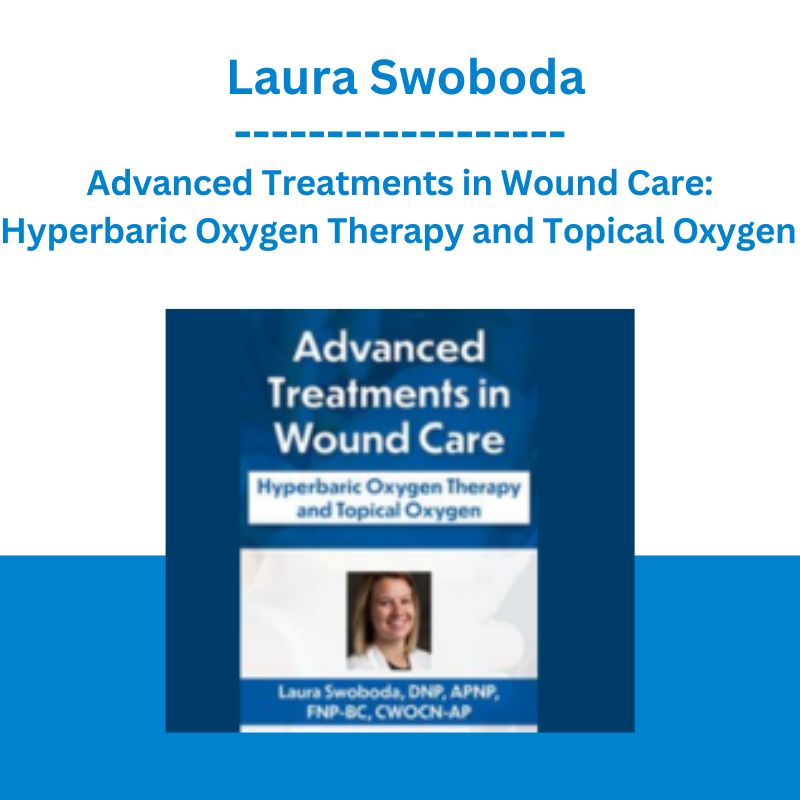*** Proof of Product ***
Exploring the Essential Features of “Advanced Treatments in Wound Care: Hyperbaric Oxygen Therapy and Topical Oxygen – Laura Swoboda”
Oxygen is an important component in wound healing. It contributes to a number of crucial processes including immune response, fibroblast replication, collagen deposition, and angiogenesis. Wounded tissue requires far more oxygen to stabilize and heal than intact tissue. Both hyperbaric oxygen therapy (HBOT) and transdermal continuous oxygen (TCO) therapy contribute additional oxygen to support wound healing. Understanding the differences and similarities between these therapies assists clinicians in choosing which modality may be the best fit for patient goals and clinical outcomes.
Speaker
Laura Swoboda, DNP, APNP, FNP-BC CSWCN-AP®
Laura Swoboda, DNP, APNP, FNP-BC CSWCN-AP®, is a professor of health sciences, family nurse practitioner, and certified wound specialist in Milwaukee metro, Wisconsin. Dr. Swoboda is on the National Pressure Injury Advisory Panel (NPIAP)’s Prophylactic Dressing Standards Initiative Task Force, a member of the editorial board for the Wound Care Learning Network and Wound Management and Prevention, and on the board of directors for the Wound, Ostomy, and Continence Nursing Certification Board (WOCNCB) and the Association for the Advancement of Wound Care (AAWC).
Speaker Disclosures:
Financial: Dr. Laura Swoboda has employment relationships with The Healing Institute and Medical College of Wisconsin. She receives a speaking honorarium and consulting fee from Histologics, Hartmann, Convatec, Aroa, AOTI, Innovacyn, Solventum, Smith & Nephew. Dr. Swoboda receives a speaking honorarium and recording royalties from PESI, Inc. All relevant financial relationships with ineligible organizations have been mitigated.
Non-financial: Dr. Laura Swoboda serves on the board of directors for the Association for the Advancement of Wound Care and the Wound Ostomy Continence Certification Board. She is an editorial board member of Wound Care Learning Network. Dr. Swoboda previously was a consultant for Essity and Innovacyn.
Objectives
- Evaluate the role of oxygen in wound healing.
- Provide an overview of hyperbaric oxygen therapy history of, devices for delivery, expectations, patient selection.
- Provide an overview of transdermal continuous oxygen therapy history of, devices for delivery, expectations, patient selection.
- Apply knowledge of oxygen delivery in hard-to-heal wounds in the selection of modalities on patient presentations and goals of care.
Outline
Oxygen and the healing process
- Review oxygen as a molecule and the history of oxygen for medical use
- Discuss the role of oxygen in the wound healing process
- Limitations in routine blood oxygen transport to the wound site including disease processes that complicate this process
Hyperbaric Oxygen Therapy
- Review the history of hyperbaric oxygen therapy and medical organizations that represent its use
- Establish the definition of hyperbaric oxygen compared to other forms of oxygen delivery
- Discuss devices for the delivery of hyperbaric oxygen and how patient selection for a mono place vs a multiplace chamber may occur
- Patients undergoing hyperbaric oxygen must qualify by their medical status, comorbidities, and indications for use
- Examination approved therapeutic indications vs off-label uses of hyperbaric oxygen
Transcutaneous Oxygen Therapy
- What is TCO and how does this differ from other forms of oxygen used in medical care?
- Techniques and devices for the delivery of TCO vary, and can include multiple devices
- Discuss current limitations in the use of TCO
- Review emerging evidence on healing outcomes and ulcer recidivism in the use of TCO therapy
Target Audience
- Nurses
- Nurse Practitioners
- Physicians Assistants
- Physical Therapists
Please see the full list of alternative group-buy courses available here: https://lunacourse.com/shop/










 Akil Stokes & Jason Graystone - TierOneTrading - Trading Edge 2019
Akil Stokes & Jason Graystone - TierOneTrading - Trading Edge 2019